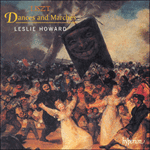The most famous of Csárdás is undoubtedly the
Csárdás macabre, which Liszt first wrote in 1881 but gradually expanded through a second draft in 1882 to the definitive version here recorded. The version prepared in good faith by Humphrey Searle, from the short draft in the British Library, and supplemented by his solo transcription of extra passages found in János Végh’s (rather than Liszt’s, as Searle thought) arrangement for piano duet, was published by the Liszt Society in its first volume, and recorded several times. But this version lacks the first 48 bars (which Liszt certainly added later) and is quite unlike Liszt’s final version in many other respects. It should be disregarded in favour of the full text as printed by the
Neue Liszt-Ausgabe. That edition also tells us that Liszt’s oft-quoted remark ‘Should one write or listen to such a thing?’ (Liszt’s original in German and French reads: ‘Darf man solch ein Ding schreiben oder anhören? Peut on écrire ou écouter pareille chose?’) found above the title on the MS has been crossed out by him with a red pencil, but that may only mean that he did not wish it published. The sentiment is appropriate enough since it anticipates that this, one of his most forward-looking works, would prove difficult for musicians and public alike. Bartók knew the work, although the copy he prepared for publication in 1912 never saw fruition, so the first complete and accurate edition of the work had to wait until the
Neue Liszt-Ausgabe of 1984, where further information about the sources of the work may be found.
from notes by Leslie Howard © 1994
La Csárdás la plus connue est sans aucun doute la
Csárdás macabre que Liszt composa en 1881 mais qu’il développa au travers d’un second brouillon en 1882 pour aboutir à cette version finale contenue sur cette enregistrement. La version faite de toute bonne foi par Humphrey Searle, à partir du court brouillon annoté qui est archivé à la British Library, et supplémentée par ses transcriptions solo de plusieurs passages de l’arrangement pour quatre mains de János Végh (plutôt que de Liszt, comme le pensait Searle), fut publiée par la Liszt Society dans son premier volume, et enregistrée à plusieurs reprises. Mais il manque à cette version les 48 premières mesures (que Liszt a certainement ajoutées ultérieurement) et c’est pourquoi celle-ci ne ressemble guère à la version finale. Le texte publié dans le
Neue Liszt-Ausgabe doit être préféré à cette version. Cette édition contient également l’inscription manuscrite suivante «Darf man solch ein Ding schreiben oder anhören? Peut-on écrire ou écouter pareille chose?», écrite de la main de Liszt, inscription qui réapparaît à maintes reprises dans le texte. Cette inscription, couchée au dessus du titre dans le manuscrit, est rayée à l’encre rouge, mais cela peut simplement signifier qu’il ne désirait pas que cette version soit publiée. Cette interprétation est tout à fait plausible dans le sens où cette œuvre, l’une des plus avant-gardistes qu’il ait composées, aurait semblée ardue à la fois aux musiciens et au public de l’époque. Bartók connaissait l’œuvre, bien que la copie sur laquelle il travailla en 1912 ne fut jamais publiée. L’édition complète et fidèle de cette œuvre dut attendre 1984 afin d’être publiée dans le
Neue Liszt-Ausgabe où sont répertoriées de plus amples informations à son sujet.
extrait des notes rédigées par Leslie Howard © 1994
Français: Béatrice Lesade
Das berühmteste dieser Csárdás ist zweifellos der
Csárdás macabre, den Liszt zuerst im Jahre 1881 verfaßte und den er dann allmählich über einen zweiten, 1882 entstandenen, Entwurf zu der maßgeblichen, hier aufgenommenen Version erweiterte. Die mit Hilfe des kurzen Entwurfs im Besitze der British Library von Humphrey Searle in gutem Glauben ausgearbeitete Fassung, die er durch seine Solo-Transkription zusätzlicher, in János Véghs (nicht wie Searle fälschlich annahm, in Liszts) Bearbeitung für Klavier zu vier Händen enthaltener Passagen ergänzt hatte, wurde von der Liszt Society in ihrem ersten Band veröffentlicht und wiederholt in Schallplattenaufnahmen aufgezeichnet. Aber in dieser Fassung fehlen die ersten 48 Takte (die Liszt mit Sicherheit später hinzugefügt hatte) und sie weicht in manch anderer Hinsicht von Liszts Endfassung ab. Daher sollte sie zugunsten des vollständigen Textes, wie er in der
Neue Liszt-Ausgabe erscheint, außer acht gelassen werden. Diese Ausgabe teilt uns auch mit, daß Liszts oft zitierte Bermerkung „Darf man solch ein Ding schreiben oder anhören? Peut on écrire ou écouter pareille chose?“, die im Manuskript über dem Titel stand, von ihm mit einem Rotstift durchgestrichen wurde, doch daß dies lediglich bedeuten mag, daß er sie nicht veröffentlicht haben wollte. Dieser Gedanke des Komponisten ist durchaus angebracht, da er vorwegnimmt, daß dieses Werk, welches eines seiner am meisten in die Zukunft gewandten ist, sich sowohl für die Musiker als auch fürs Publikum als schwierig erweisen würde. Bartók kannte das Werk, doch wurde sein Plan der Veröffentlichung einer von ihm 1912 abgefaßten Kopie nicht verwirklicht. Die erste vollständige und genaue Ausgabe dieses Musikstücks gab es daher erst in der
Neue Liszt-Ausgabe von 1984, in welcher weitere Angaben zu seinen Quellen gefunden werden können.
aus dem Begleittext von Leslie Howard © 1994
Deutsch: Angelika Malbert



 Liszt: Complete Piano Music
Liszt: Complete Piano Music Liszt: The complete music for solo piano, Vol. 28 - Dances and Marches
Liszt: The complete music for solo piano, Vol. 28 - Dances and Marches
